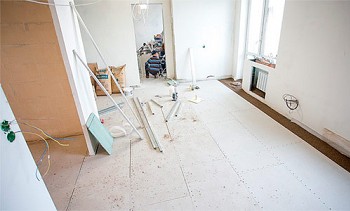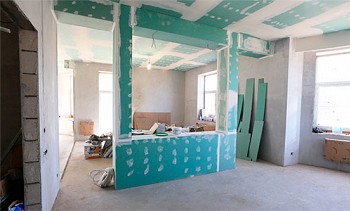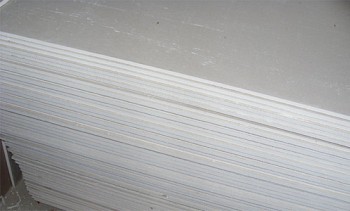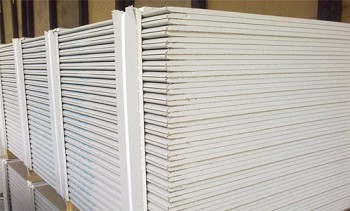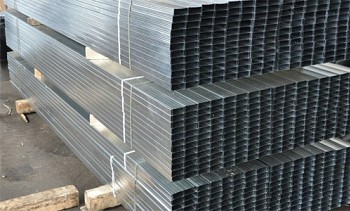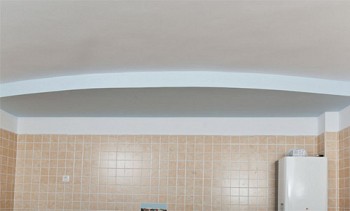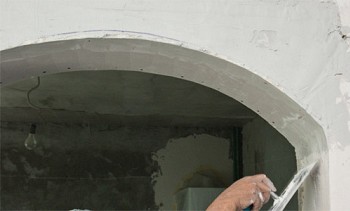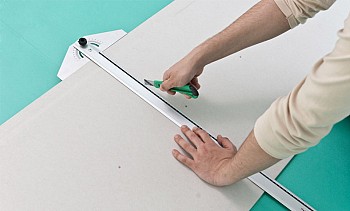The practical use of any building material requires a certain set of special devices. In particular, without a tool for drywall and profiles it is impossible to imagine the creation of an arch or partition structure, as well as the construction of more complex elements from gypsum board. From this article you will learn what types of tools you may need in the process of working with drywall, what is their purpose and how to use them.
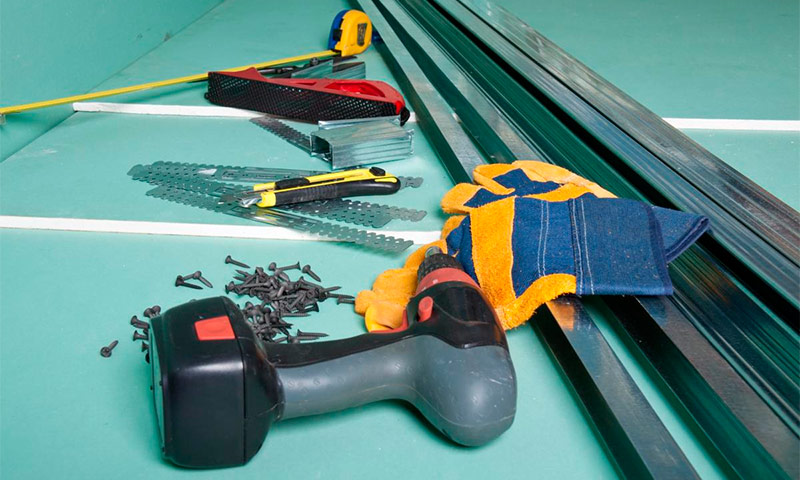
Content:
Drywall carrying and supporting equipment
When working with drywall, it is not very convenient to perform some actions, since massive slabs often have to be transferred from one place to another. Also, certain difficulties may arise in cases where it is necessary to keep the mounted material at a height. Special devices, which are used by many professional masters, help to cope with such tasks.
Drywall Carrying Handles
There are models of carrying pens designed for both working in pairs and for one person. In the first case, a set of two handles is used, which allows GKL to be gripped at the required height and gently move the material, holding it in the desired position with a free hand.


For work carried out alone, a carrier made of plastic or metal is intended, due to the device of which the sheet is fixed reliably enough. Such a device is convenient to use at home if repairs are carried out without the help of assistants.

Tricycle trolley
To transport drywall in a large construction site, it is advisable to use a trolley on which you can load up to 400 kg of material. The length of such a device is usually about 1.2 m, and the width is not less than 0.6 m. If necessary, transport the sheets they are installed on the edge, observing a small angle of inclination. It should be noted that the larger the diameter of the wheels of the trolley, the easier it is to carry out transportation on the territory that is not cleared of construction waste.

Mounting support
This tool for working with drywall is a device in the form of a lever located on a stand, which is equipped with a metal movable stop necessary to hold the material. In the process of wall sheathing, as well as creating niches and partitions, such a device ensures the vertical position of the sheet, which is attached to the profile. At the same time, the integrity of the lower edge of the mounted GCR is maintained.


Pedal lift
It allows not only to quickly fix sheets in the process of wall cladding, but also to press drywall to the ceiling. However, without the help of a partner, it will be difficult to install drywall, since such a design limits the movement of the master.

Frame lift
For some complex work, in particular regarding the installation of ceiling structures or ventilation elements, the ideal option would be to use such a mobile device as a frame hoist. With it, you can move and set sheets in both vertical and horizontal positions. Such a tool for installing drywall allows you to securely fix the material on the frame, which is especially convenient when creating continuous suspended ceilings.The lift is equipped with wheels, due to which the GKL moves almost effortlessly, which in turn has a positive effect on the quality of installation.
The total weight of such a device is usually about 26 kg. At the same time, it can be used in works performed at a height of up to 3 m. The maximum allowable weight of the materials being transported is 50 kg. To mount sheets of drywall, having at the disposal of such a device, one person may well, without attracting assistants.


Some specifications of models offered by different manufacturers may vary slightly. In addition, there is such a device as a spreader lift. It is mainly used in work with suspended ceilings.


In a limited budget, not every home master can afford to buy a special device. However, it will be quite difficult to install a solid suspended ceiling without auxiliary equipment. In this case, it makes sense to independently produce T-shaped supports in the amount of two pieces. The length of the rack of such a product is determined based on the height of the room, so that it is possible to ensure a tight fit of the material to the ceiling. Such devices of the master were successfully used before the first lifts appeared on sale. During the installation, the presence of a partner is assumed.


Measuring tools for marking and dimensional control
High-quality installation of gypsum plaster requires accurate marking and preliminary measurement of the material. The classic tools include roulette, level, plumb. However, there are also many modern devices that can significantly speed up the process and achieve better results. Let's consider what devices are used by experienced craftsmen today.
Roulette
This is a well-known measuring tool, the body of which is made of plastic or metal, and inside is a measuring tape. The most commonly used tape measures are 3 m long. However, to perform various lengthy measurements, it is better to have a five-meter tape measure.

Level
This tool, used to work with drywall, allows you to control the slope of any vertical or horizontal surface. The product consists of a metal case with an ampoule mounted in it (there may be several), which is filled with an alcohol-containing liquid having a certain color. The angle of the base or structural element is determined by the inside of the air bubble. With a surface ideally even with respect to the ground, it should occupy a middle position without going beyond the limits of the existing marks.
Modern manufacturers offer a variety of level models of various sizes. Their differences may lie in the number of built-in tubular indicators, as well as their location. Some products are equipped with magnets, which is convenient when aligning elements of metal structures. The most popular are devices with laser pointers, which allow marking up as quickly as possible.

Metrostat 300
A sliding tool equipped with a measuring scale and bubble level, the length of which can reach 3 m. With its help, you can control the horizontal and vertical position of the structure. In addition, there is a special nozzle designed to hold the GCR in an upright position during installation.
Hydraulic level
It makes it possible to break down horizontal planes, as well as transfer marks from one surface to another. Mostly the hydraulic level is used in work with suspended ceilings. Marking lines are defined using a hose, the length of which, as a rule, is at least 10 m.

Linear laser level
With the help of modern measuring technology, almost perfect results can be achieved.One of the devices widely used in work with drywall is a linear laser level (plane builder), which allows using projections that are perpendicular to each other to create projections both vertically and horizontally, which makes it possible to perform high-quality marking of absolutely any plane.

Laser Rotational Level
This device, operating in different modes, allows you to set the vertical, horizontal and inclined planes. The laser beam in such devices constantly rotates around its axis. Thus, he is able to project a plane on 3600. These devices are convenient to use when working in large rooms.

Square
This tool is primarily used for marking corners. Structurally, the device is quite simple and is a ruler of a certain length, mounted in a metal base. With it, you can also control the rectangularity of certain elements.

Tools required for cutting and processing GKL
There are a number of tools and devices that are used for cutting and processing drywall sheets.
Cutting table
This device consists of two support legs with persistent elements attached to them. A grid cover is located on top, on one side of which a clamping ruler of an appropriate length is fixed by means of special clamps.
Folding workbench table
An equally convenient device, the main difference of which is a removable cover, which allows you to fold the support frame if necessary for subsequent transportation. To do this, special loops are located that are located on the end rails.
The cutting of material is carried out using a construction knife or a cutting tool intended directly for drywall.
Sheet cutting knives
To cut the upper cardboard layer of GCR use special knives.


Narrow cutter
The device is necessary so that it is possible to cut off a strip from a full-format sheet, the width of which does not exceed 120 mm. This cutting is carried out by two discs, simultaneously cutting the material on both sides. Some models of such devices are equipped with an additional handle, which makes them more convenient to use.

Wide cutter
It works on the same principle, but is used to cut larger pieces of drywall. The permissible limit of the width of the sheets in this case is 630 mm. At the same time, cutting with an ordinary knife gives almost the same results, which is due to the rather low demand for such devices.

Hacksaw
To create rectangular holes or elements with complex shapes, you will need a hacksaw with a minimum blade width and small teeth. Such tools are made specifically for use with GCR.


Peeling planer
The tool is a type of rasp, with which the edges of the cut sheets are processed, which allows you to align them and achieve perfect smoothness. The tool involves the use of removable webs, the installation of which is carried out by loosening and tightening the tension screw.

Edge planer
The edge cutter is used to trim the edges of the edges in order to create chamfers. In this case, the angle of inclination can be 22.5 or 45 degrees. Before using the edge cutter, the ends of the sheet must be leveled with a peeling planer.

Circular milling cutter
A special nozzle for a drill allows you to make standard openings in drywall that are necessary for the installation of all kinds of communication elements. Such products are mainly sold in sets and have different diameters, which makes it possible to choose a cutter for a specific purpose.

Ballerina for GKL
This tool also creates holes. At the same time, their variable diameter is assumed, which can vary in the range of 12-320 mm.The device consists of an aluminum case and a particularly durable cutting element in the form of a roller made of carbide materials.

Needle roller
This device is used exclusively in cases where you need to give the material an arched shape or create a different kind of curved surface. Water is applied to the gypsum board sheet, which penetrates directly into the body of the gypsum layer during the perforation process. The depth of the holes is 5-7 mm, and their diameter ranges from 2-3 mm. In this case, the concave should be exactly the side on which the recesses are made.

Scissors for metal
The tool will be needed in the process of cutting the profile. This is a great alternative to a hacksaw for metal, which is not always convenient to work in certain conditions.

Power tools
These include, first of all, Bulgarian and jigsaw, which in some cases can greatly simplify the work. Also, small-sized electric shears, allowing you to get to hard-to-reach places, will not be amiss.
Tools for mounting profiles and sheets
Profiler Profiler
In the metal frame, it is often necessary to pierce the holes necessary for laying various communication elements. The notch is a way to make holes with a diameter of 25 mm in a profile 1 mm thick.


Profile clamp pliers
This device is used to fasten the profile when mounting the frame. It allows you to connect profiles by the method of notching with a bend, without using additional fasteners. To secure the fixation, usually several cuts are made, the distance between which is about 5 mm. Moreover, compared with the use of rivets, the surface of the frame remains perfectly smooth.

Corner cutter
Designed for fastening metal protective profiles on the outer corners of partitions made of plasterboard sheets. Usually on sale, it is additionally equipped with a rubber mallet. Fixation of PU profiles occurs mechanically.
Hammer drill
A tool familiar to almost every man, used for drilling holes in a wide variety of building materials, including gypsum plaster and gypsum plaster. It will be required, first of all, for drilling holes on the dowels when fixing profiles, as well as when installing sockets and switches. For drilling metal structural elements, it is recommended to use special drills with a conical sharpening.

Screwdriver
Since when working with this tool it is possible to adjust the moment of screwing, it is practically impossible to accidentally spoil the mounted drywall. The electric motor will be stopped in a timely manner. Improved models designed specifically for working with GCR have a rotation speed of up to 4000 rpm.
This makes it possible to quickly and effortlessly screw self-tapping screws into the metal structural elements. In such tools, a stepwise method for adjusting the depth of screwing is provided. Today you can purchase both a network and a battery model of a screwdriver, as well as all kinds of bit sets.

Plastering tools for working with drywall sheets
Tools designed for kneading and applying various putty mixtures used for GKL and GVL, are usually made of stainless materials that can withstand corrosive processes. Moreover, the quality of the finish, first of all, depends on the observance of the technology for preparing the mixture. Mixing putty can be carried out using an electric drill or use a special mixer. All nozzles for mixing solutions have their own design features and purpose.
Mortar nozzles

The nozzle with a round blade is designed to work with dispersion paints, sealants and adhesives.

A spiral nozzle with a ring will be needed to knead filler mixtures, leveling materials and plaster.

The left-side spiral nozzle, which has three branches, is mainly used for liquid mixtures characterized by a fairly low density.

The spiral nozzle with a right-handed spiral is most suitable for heavy mixtures with a high degree of viscosity.

A screw nozzle with a ring is used to mix liquid materials: primers, varnishes, adhesives and mixtures intended for spraying.
Spatial spatula 50 - 70 cm for seams
A spatula measuring 50 - 70 cm. Ideal for grouting. It is convenient for them to heat the reinforcing tapes that are mounted on the joints of the gypsum board, as well as to putty the mixture along the seam. When mounting trimmed edges, non-standard seams are often formed, for the quality processing of which it makes sense to purchase a large spatula.

In addition, there are special tools designed to work with internal and external corners. Such spatulas have special shapes.


Spatula with screwdriver
This device is used to putty the joints of gypsum plasterboards and the recesses of the screws remaining from the cooking. At the same time, when puttying the recesses from the screws, it is possible to quickly fix the existing defects in the installation of drywall in those places where the screw heads protrude above the surface of the drywall sheet.

Wide spatula
For continuous filling of the surface of gypsum boards use wide spatulas, the size of 180 cm or more.

Putty Falcon
Also, in the process of puttying, a metal shield will not be superfluous, with which it is convenient to bring ready-to-use puttying material to the place of work. This is a fairly lightweight product, equipped with a perpendicularly located handle.

Grinding tools
Sanding grater
The product in the form of a plate equipped with special clamps for replacing the mesh is used in the dry grinding process of GKL sheets and joints treated with a putty mixture.

Extendable grater
Here, in addition to the clamps, there is a handle, which is fixed by a hinge method. The tool is intended primarily for working with hard-to-reach spots. If necessary, the handle can be independently extended, thus increasing the radius of action. This will allow the master to be outside the area with the greatest dust formation.

Vibratory grinding machines
These devices allow you to accelerate the surface cleaning process, which is due to a sufficiently high vibration frequency. In addition, such devices are capable of absorbing dust that accumulates in a special dust collector.




